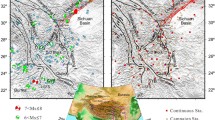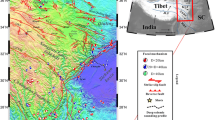Abstract
The northeastern Tibetan Plateau (TP) is one of the best places to investigate the growth mechanism of the Tibetan Plateau due to its dramatic deformation. We calculate regional gravity changes and 3-D crustal deformations based on geodetic datasets, such as campaign gravity, GPS, and leveling observations. Obvious negative–positive gravity changing signals appear in both sides of the Qilian-Haiyuan fault, which indicate material accumulation and reduction, respectively. We therefore suggest that the northeastern TP thrust towards the North China Craton (NCC) is due to the northward advance of Tibetan Plateau. The crustal movement velocity decreases stepwise from south to north, which is bounded by the thrust or strike-slip faults, and varies from 15.4 ± 0.1 mm/year in the Songpan-Ganzi block to 4.7 ± 0.02 mm/year in the Alax block. The tectonic uplift rate from leveling observations, with surface loads and glacier isostatic adjustment (GIA) deformation corrected, show the fastest uplift zone occurring in the south Liupan Shan fault and West Qinling fault, with a rate of approximately 4.3 ± 0.1 mm/year. In addition, we compare the material movement rate between the upper crust and mid-lower crust, and the results reveal that material movement in the mid-lower crust is faster than that in the upper crust, which may suggest the existence of a mid-lower crustal flow beneath the West Qinling block. We propose a geodynamic and kinematic model to quantitatively interpret the crustal deformations in the northeastern TP, which is helpful for further understanding the growth mechanism of the northeastern TP.







Similar content being viewed by others
References
Bohling, G. (2005). Kriging. http://people.ku.edu/~gbohling/cpe940.
Cardozo, N., & Allmendinger, R. W. (2009). SSPX: A program to compute strain from displacement/velocity data. Computers & Geosciences, 35(6), 1343–1357. https://doi.org/10.1016/j.cageo.2008.05.008
Deng, Y., Li, J., Song, X., & Zhu, L. (2018). Joint inversion for lithospheric structures: Implications for the growth and deformation in northeastern Tibetan Plateau. Geophysical Research Letters, 45, 3951–3958.
Gao, R., Wang, H., Yin, A., et al. (2013). Tectonic development of the northeastern Tibetan Plateau as constrained by high-resolution deep seismic-reflection data. Lithoshere, 5(6), 555–574. https://doi.org/10.1130/L293.1
Hao, M., Wang, Q., Shen, Z., et al. (2014). Present day crustal vertical movement inferred from precise leveling data in eastern margin of Tibetan Plateau. Tectonophysics, 632, 281–292.
Herring, T. A., King, R. W., & McClusky, S. C. (2015a). GAMIT reference mannual, GPS analysis at MIT, release 10.6. Massachusetts Institute of Technology.
Herring, T. A., King, R. W., & McClusky, S. C. (2015b). GAMIT reference mannual, Global Kalman filter VLBI and GPS analysis program, release 10.6. Massachusetts Institute of Technology.
Huang, Z., Tilmann, F., Xu, M., et al. (2017). Insight into NE Tibetan Plateau expansion from crustal and upper mantle anisotropy revealed by shear-wave splitting. Earth and Planetary Science Letters, 478, 66–75. https://doi.org/10.1016/J.EPSL.2017.08.030
Jiang, C. X., Yang, Y. J., & Zheng, Y. (2014). Penetration of mid-crustal low velocity zone across the Kunlun Fault in the NE Tibetan Plateau revealed by ambient noise tomography. Earth and Planetary Science Letters, 406(15), 81–92. https://doi.org/10.1016/J.EPSL.2014.08.040
Lease, R., Burbank, D., Zhang, H., Liu, J., & Yuan, D. (2012). Cenozoic shortening budget for the northeastern edge of the Tibetan Plateau: Is lower crustal flow necessary? Tectonics, 31, TC3011.
Li, Y., Liu, M., Wang, Q. L., & Cui, D. (2018). Present-day crustal deformation and strain transfer in northeastern Tibetan Plateau. Earth and Planetary Science Letters, 487, 179–189.
Molnar, P., England, P., & Martinod, J. (1993). Mantle dynamics, uplift of the Tibetan Plateau, and the Indian monsoon. Reviews of Geophysics, 31(4), 357–396.
Pan, Y., Shen, W., Shum, C., et al. (2018). Spatially varying surface seasonal oscillations and 3-D crustal deformation of the Tibetan Plateau derived from GPS and GRACE data. Earth and Planetary Science Letters, 502, 12–22.
Peltier, W. R., Argus, D. F., & Drummond, R. (2018). Comment on “An Assessment of the ICE-6G_C (VM5a) Glacial Isostatic Adjustment Model” by Purcell et al. Journal of Geophysical Research: Solid Earth, 123, 2019–2018. https://doi.org/10.1002/2016JB013844
Royden, L., Burchfiel, B., & van der Hilst, R. (2008). The geological evolution of the Tibetan Plateau. Science, 321(5892), 1054–1058.
Tapponnier, P. (2001). Oblique stepwise rise and growth of the Tibet Plateau. Science, 294(5547), 1671–1677.
Wang, M., & Shen, Z. K. (2020). Present-Day Crustal Deformation of Continental China Derived from GPS and Its Tectonic Implications. Journal of Geophysical Research: Solid Earth, 125(2), e2019JB018774.
Xu, X., Wu, X., Yu, G., Tan, X., & Li, K. (2017). Seismo-geological signatures for identifying M≥ 7.0 earthquake risk areas and their preliminary application in Mainland China. Seismology and Geology, 39(2), 219–275.
Ye, Z., Gao, R., Li, Q. S., et al. (2015). Seismic evidence for the North China plate underthrusting beneath northeastern Tibet and its implications for plateau growth. Earth and Planetary Science Letters., 426, 109–117. https://doi.org/10.1016/j.epsl.2015.06.024
Ye, Z., Gao, R., Lu, Z. W., et al. (2021). A lithospheric-scale thrust-wedge model for the formation of the northern Tibetan plateau margin: Evidence from high-resolution seismic imaging. Earth and Planetary Science Letters, 574, 117170. https://doi.org/10.1016/j.epsl.2021.117170
Zhang, G., Shen, W., Fu, G., Li, Z., Zhu, Y., & Wang, Y. (2021). Moho changes beneath the northeastern Tibetan Plateau revealed by multiple geodetic datasets. Journal of Geophysical Research: Solid Earth, 126, e2021JB022060. https://doi.org/10.1029/2021JB022060
Zhao, P., Chen, J., Li, Y., Liu, Q., Chen, Y., Guo, B., & Yin, X. (2021). Growth of the northeastern Tibetan Plateau driven by crustal channel flow: evidence from high-resolution ambient noise imaging. Geophysical Research Letters, 48, e2021GL093387. https://doi.org/10.1029/2021GL093387
Zhu, Y. Q., Guo, S. S., Li, T. M., et al. (2014). Dynamic variation of gravity field before and after the Minxian-Zhangxian Ms=6.6 Earthquake on July 22, 2013, Gamsu, China. Seismology and Geology (in Chinese), 36(3), 667–676. https://doi.org/10.3969/j.issn.0253-4967.2014.03.010
Zhu, Y. Q., Liang, W. F., & Zhang, S. (2018). Earthquake precursors: Spatial-temporal gravity changes before the great earthquakes in the Sichuan-Yunnan area. Journal of Seismology, 22(1), 217–227.
Zhu, Y. Q., Zhang, Y., Zhang, G. Q., Liu, F., & Zhao, Y. F. (2020). Gravity variations preceding the large earthquakes in the Qinghai-Tibet Plateau from 21st century. Chinese Science Bulletin (in Chinese), 65(7), 622–632. https://doi.org/10.1360/TB-2019-0153
Acknowledgements
The gravity data, leveling data, and GPS data used in this study are from the National Key Scientific Projects “Crustal Movement Observation Network of China” (CMONOC). We express our gratitude and thanks to all our Chinese participants in constructing the network and making the data sets available. We thank Dr. Janusz Bogusz and the two anonymous reviewers for their critical and helpful comments.
Funding
This study is supported by the National Natural Science Foundation of China (41904082, 41874092) and Science for Earthquake Resilience, China Earthquake Administration (XH21053).
Author information
Authors and Affiliations
Contributions
GZ contributed the conception of the study. GZ and TZ performed the experiments. GZ, YZ, TZ, and ZL contributed significantly to analysis and manuscript preparation. YW and WL helped perform the analysis with constructive discussions.
Corresponding author
Ethics declarations
Conflict of Interest
The authors declare that they have no conflict of interest.
Additional information
Publisher's Note
Springer Nature remains neutral with regard to jurisdictional claims in published maps and institutional affiliations.
Rights and permissions
About this article
Cite this article
Zhang, G., Zhu, Y., Zhang, T. et al. Crustal Deformations in the Northeastern Tibetan Plateau Revealed by Multiple Geodetic Datasets. Pure Appl. Geophys. 180, 703–714 (2023). https://doi.org/10.1007/s00024-022-03009-9
Received:
Revised:
Accepted:
Published:
Issue Date:
DOI: https://doi.org/10.1007/s00024-022-03009-9




